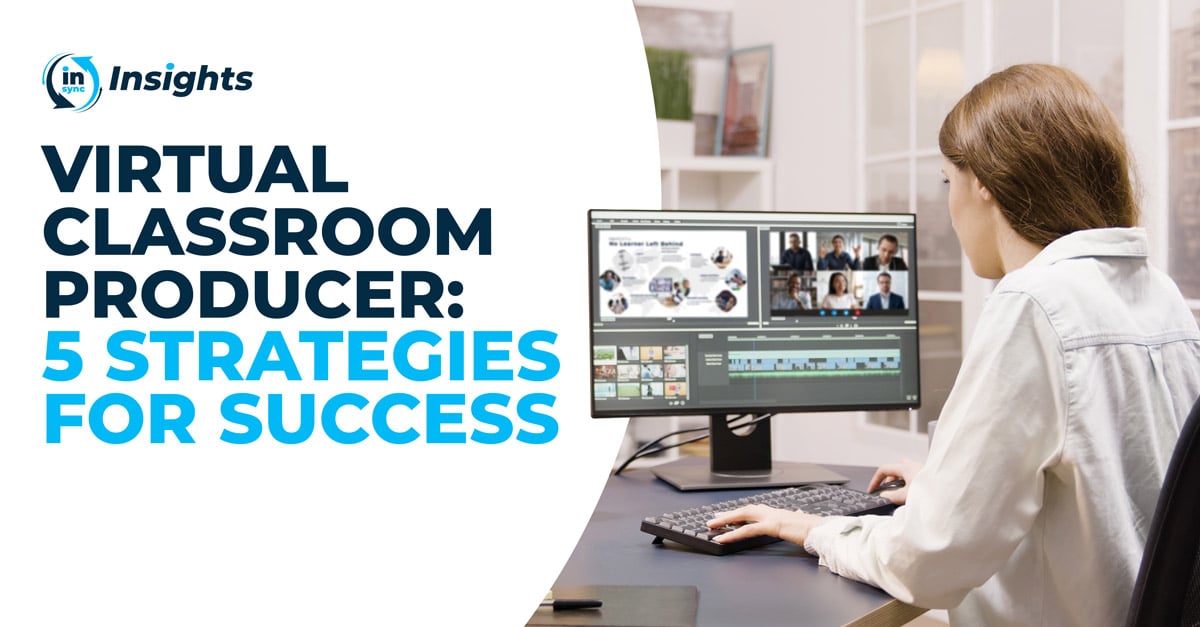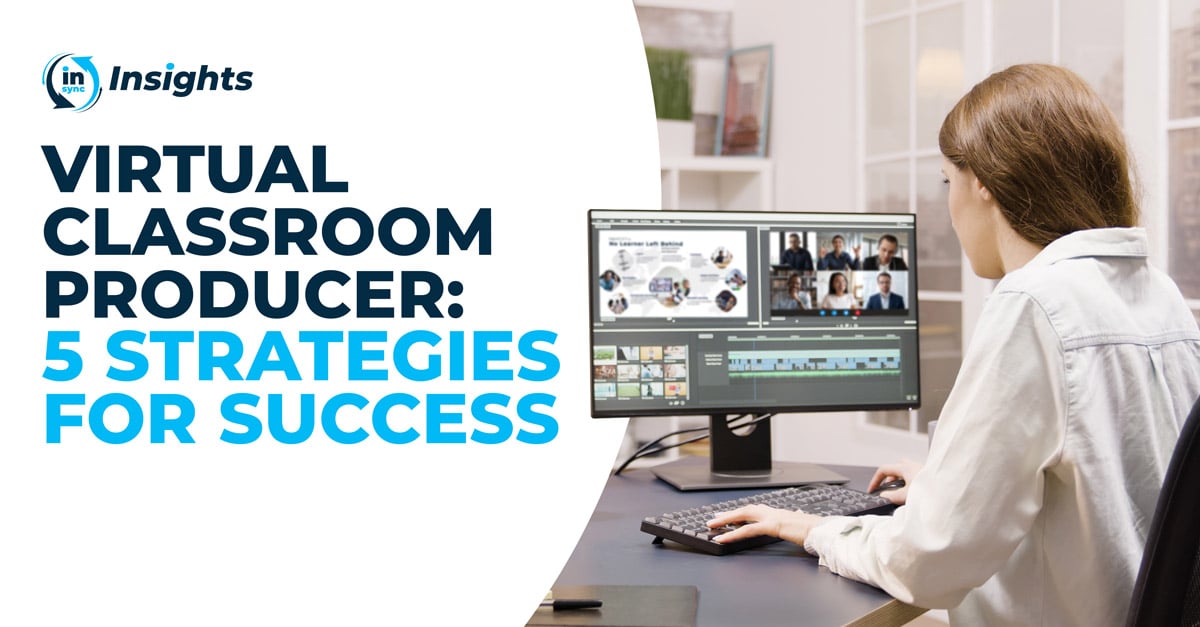The Pillars of Virtual Classroom Production
Support. Advocate. Manage. Download the infographic. Whether known as a producer, host, or moderator, this pivotal role often works behind the...
4 min read
 Jennifer Hofmann
:
Oct 5, 2023 10:35:23 AM
Jennifer Hofmann
:
Oct 5, 2023 10:35:23 AM

Regardless of whether you're a novice stepping into the role or a seasoned veteran with years of event hosting experience, these five strategies will pave the way for your success as a virtual classroom producer.

In today's fast-paced world, organizations are increasingly transitioning to the virtual classroom. This shift presents a unique challenge for trainers and learning professionals accustomed to face-to-face interactions. Suddenly, they find themselves supporting subject matter experts or experienced virtual facilitators in a completely different, yet highly dynamic, environment.
If you find yourself in this situation, either by circumstance or choice, fear not! There are several strategies you can employ to thrive as a producer in the virtual classroom:
The role of a producer in a virtual classroom can greatly vary from session to session. Therefore, it's crucial to clarify your responsibilities before each event.
Discuss expectations with stakeholders or program managers to determine your support role in the lesson.
Typically, producers tend to fall into two primary categories: technical and instructional.
Technical producers are responsible for managing the platform, initiating complex collaborative activities such as breakout rooms, and providing behind-the-scenes support to learners and facilitators.
Instructional producers not only comprehend the platform's tools and functionality but also act as co-facilitators who are adept at modifying content spontaneously.
Understanding whether your primary duties align more with a technical producer or an instructional producer will guide your preparatory approach for each session, ensuring that you can fulfill your role effectively and efficiently.
Communication is key. Establish clear and open lines of communication with the rest of the delivery team. Regularly check in with them to address any concerns, answer questions, and ensure everyone is on the same page.
Our team advocates for the use of both session walk-throughs and full rehearsals. These pre-event meetings provide the opportunity for the producer to meet with the virtual classroom facilitator and discuss support style. Producers should verify the facilitator’s expectations around pre- and post- event tasks, the types of tools the session includes, to what extent they (the producer) are expected to manage those tools, and private communication choices. Ultimately, a producer’s to-do list depends on the type of production required by program managers and facilitator preferences.
This is such a critical strategy for virtual classroom producers. In virtual classrooms, the role of a producer extends beyond managing technical aspects and facilitating smooth sessions. As a virtual classroom producer, you are in a unique position to champion the needs and interests of the learners.
Virtual training sessions should not merely be about information sharing; they need to be comprehensive learning experiences that foster learner engagement, interaction, and knowledge retention. Here's how you, as a producer, can advocate for learners and support their engagement:
Understand the Learners' Needs: Get to know your audience—their backgrounds, learning styles, and objectives. This understanding will allow you to tailor sessions to their needs, making the content more relevant and engaging.
Foster an Interactive Environment: Encourage active participation from learners by incorporating interactive elements like polls, quizzes, breakout sessions, and discussion forums. This not only makes the session more engaging but also promotes peer-to-peer learning.
Ensure Accessibility: Make sure that all learners, regardless of their technical proficiency or accessibility needs, can participate fully in the session. This may involve providing tech support, ensuring that materials are available in various formats, or using closed captions for videos.
Solicit Feedback: Regularly collect feedback from learners about their experience. This could be through surveys, informal chats, or suggestion boxes. Use this feedback to continuously improve and adapt your sessions.
Be the Learners' Voice: Often, learners may hesitate to voice concerns or issues directly to facilitators or subject matter experts. As a producer, represent these concerns on their behalf, ensuring they are addressed and resolved.
With the increase in remote work, there’s a misconception that simply attending a bunch of Zoom meetings with your team qualifies someone to manage complex, technical virtual learning events. Truthfully, though, there’s a huge difference between joining a listen-in/check-in with a manager, and guiding learners and supporting facilitators through a complex training experience using virtual classroom software.
If you cannot devote time to detailed professional development, we encourage you to schedule practice time in the target virtual classroom platform. Invite a colleague or two so that you can walk through helping someone connect to different audio options, sorting them into (and bringing them out of) breakout rooms, and using the available annotation tools.
Take the time to familiarize yourself with the virtual classroom platforms and tools available to you. Understanding their functionalities and features will empower you to effectively manage the technology while leveraging your existing skills.
While your role as a virtual classroom producer might primarily revolve around handling technical aspects, it's vital to familiarize yourself with the session's content. This doesn't necessitate you becoming an impromptu Subject Matter Expert, ready to step in as an emergency facilitator. Rather, it's about comprehending the session's flow to efficiently perform your producer duties.
By knowing the content, you can discern verbal and contextual cues that guide your actions during the session. You can also assist the facilitator in maintaining a steady pace throughout the session, and learners can anticipate concluding a virtual learning event punctually. Producers who can aid facilitators in managing the timing of activities and content delivery bring added value to the entire program.
By adopting these strategies, you'll not only enhance the quality of your virtual training sessions but also ensure they are learner-centric. Remember, when learners feel valued and heard, they are more likely to engage, participate actively, and ultimately, learn more effectively. As a virtual classroom producer, advocating for these learners is one of the most impactful roles you can play.
Since the virtual classroom landscape is constantly evolving, it's crucial to stay updated on the latest trends, features, and best practices. Attend webinars, participate in online communities, and seek out professional development opportunities to enhance your knowledge and skills.
By following these strategies, you'll position yourself for success as a virtual classroom producer, helping to create engaging and impactful learning experiences for all participants.
Like every learning and development role, production skills range from entry-level to expert. Through practice, ongoing education, and experience, you can become a virtual learning MVP!
Partner with InSync and embark on your journey to become a Master Virtual Producer! Here's a sneak peek into what you'll do:
Earn your Virtual Classroom Producer Certification today and become the indispensable MVP your organization needs. Ready to get started? Take the first step by enrolling in the Master Virtual Producer program.

Support. Advocate. Manage. Download the infographic. Whether known as a producer, host, or moderator, this pivotal role often works behind the...

Virtual Classroom Producers Have a Critical Role to Play in Virtual Learning Environments The role of the virtual classroom producer has changed...

In the recent rush to move so much training from face-to-face to the virtual setting, there’s a great deal of conversation about the technology:...